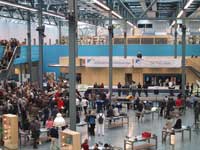Background
The shift from designing stand-alone products to developing products which are contextually aware of the user and co-exist in the user's environment has numerous implications for design research. Rather than considering interaction as a one-off experience, consideration is given to the user in a given context interacting with a range of products distributed in space and time. Context sensitive products should be able to adapt to user needs which may evolve over time or significantly differ between users and cultures.Research work in the Social and Contextual Interaction Design group has begun to consider how information concerning a desired user experience can be embedded in a product and how interaction with the system can be enriched in a pleasing and non-obtrusive manner. For example, the living room atmospheres or music. Communication with an aware system should take into account the users current activity and be based upon a model of interruptibility. A multimodal approach to interaction design is needed here in determining which modalities are most appropriate given user preferences which may be task and context dependent. Collaborative dialogue may also help bridge the user-product communication gap towards understanding what the product can do and in turn towards increasing the product's understanding of the user. User personality and product expression are central in shaping the user's degree of willingness to engage a product.
In terms of research methodology, research through design is utilized in the SCID group, to explore the wide range of factors which may shape the design of contextually aware products. Working prototypes are developed in Studio Home/Office. The lab is equipped with local and wide area displays, tangible interfaces, a high-speed wireless appliance control and context sensitive sensor networks. The physical living room space of the lab has been desiged to offer a restoratative envrionment.
Towards considering product usage over time, living probes combined with ethnographic studies are utilized. For example an Internet Kiosk as a probe for rapidly gaining user requirements in context, is being setup in rural India.
Smart Surroundings
The SCID group is active the Smart Surroundings project as leader of the workpackage on user interaction. Several Smart Surroundings projects within SCID are currently under way, including: > Affective tangible interaction; towards reducing stress> Stress-reductive work environments
> Restorative Room
> GSR Mouse design with LogiSens
> Mobile Stress Awareness
> ICT booth for rural India
Collaborations
The SCID group is currently developing a joint design lab with the Hyperbody Research Group of the faculty of Architecture at TU Delft in the area of Interactive Buildings. The SCID group maintains scientific collaborattions with a number of national and international research groups including, faculty of Architecture of Lulea Univerisity, Mistubishi Electronic Research Labs, Microsoft Research, Roessingh Research and Development, Ubiquitous Computing Group of the Univerisity of Lancaster, and Philips Research. The group is open to new collaborations and visiting researchers. The SCID group is active in the bachelor and masters education within the faculty of Industrial Design Engineering.Group leader
Prof. Dr., MSc. David KeysonLandberstraat 15
Room 10-3B-6
2628 CD Delft
The Netherlands
T +31 15 2783646
F +31 15 2787316
Staff
Juan JimenezAadjan van der Helm
Marc de Hoogh
Rob Luxen
Natalia Romero
Martijn Vastenburg
Thomas Visser
Collaborations
Hyperbody GroupProjects
Smart SurroundingsIndependent@Home
News
Vikram Parmar, wins best paper award at Persuasive Technology, 2008See the flowerly video at http://www.vimeo.com/2275530
See David's inaugural speech at: http://studiolab.io.tudelft.nl/sustainableliving/program
Download the new visualisation of StudioHome
Living Lab
See ITD 2010 student work atL http://www.youtube.com/ideitd





